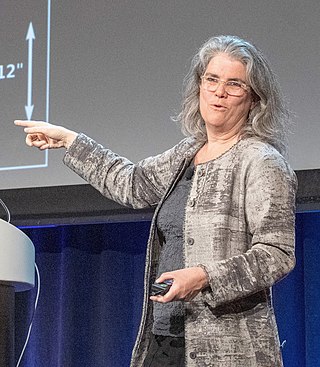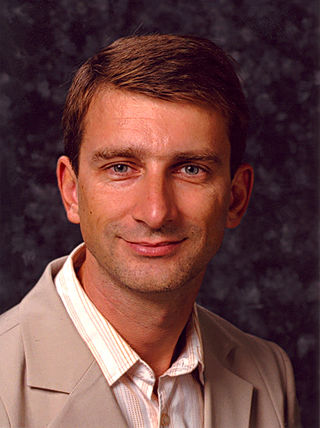Related Research Articles

Sandra Moore Faber is an American astrophysicist known for her research on the evolution of galaxies. She is the University Professor of Astronomy and Astrophysics at the University of California, Santa Cruz, and works at the Lick Observatory. She has made discoveries linking the brightness of galaxies to the speed of stars within them and was the co-discoverer of the Faber–Jackson relation. Faber was also instrumental in designing the Keck telescopes in Hawaii.

Vera Florence Cooper Rubin was an American astronomer who pioneered work on galaxy rotation rates. She uncovered the discrepancy between the predicted and observed angular motion of galaxies by studying galactic rotation curves. These results were later confirmed over subsequent decades. Her work on the galaxy rotation problem was cited by others as evidence for the existence of dark matter. The Vera C. Rubin Observatory in Chile is named in her honor.
Jeremiah Paul "Jerry" Ostriker is an American astrophysicist and a professor of astronomy at Columbia University and is the Charles A. Young Professor Emeritus at Princeton, where he also continues as a senior research scholar. Ostriker has also served as a university administrator as Provost of Princeton University.

Andrea Mia Ghez is an American astrophysicist, Nobel laureate, and professor in the Department of Physics and Astronomy and the Lauren B. Leichtman & Arthur E. Levine chair in Astrophysics, at the University of California, Los Angeles. Her research focuses on the center of the Milky Way galaxy.

Virginia Louise Trimble is an American astronomer specializing in the structure and evolution of stars and galaxies, and the history of astronomy. She has published more than 600 works in Astrophysics, and dozens of other works in the history of other sciences. She is famous for an annual review of astronomy and astrophysics research that was published in the Publications of the Astronomical Society of the Pacific, and often gives summary reviews at astrophysical conferences. In 2018, she was elected a Patron of the American Astronomical Society, for her many years of intellectual, organizational, and financial contributions to the society.

James Edward Gunn is the Eugene Higgins Professor of Astronomy at Princeton University. Gunn's early theoretical work in astronomy has helped establish the current understanding of how galaxies form, and the properties of the space between galaxies. He also suggested important observational tests to confirm the presence of dark matter in galaxies, and predicted the existence of a Gunn–Peterson trough in the spectra of distant quasars.
Amy J. Barger is an American astronomer and Henrietta Leavitt Professor of Astronomy at the University of Wisconsin–Madison. She is considered a pioneer in combining data from multiple telescopes to monitor multiple wavelengths and in discovering distant galaxies and supermassive black holes, which are outside of the visible spectrum. Barger is an active member of the International Astronomical Union.

Nancy Grace Roman was an American astronomer who made important contributions to stellar classification and motions. The first female executive at NASA, Roman served as NASA's first Chief of Astronomy throughout the 1960s and 1970s, establishing her as one of the "visionary founders of the US civilian space program".

Alessandra Buonanno is an Italian-American theoretical physicist and director at the Max Planck Institute for Gravitational Physics in Potsdam. She is the head of the "Astrophysical and Cosmological Relativity" department. She holds a research professorship at the University of Maryland, College Park, and honorary professorships at the Humboldt University in Berlin, and the University of Potsdam. She is a leading member of the LIGO Scientific Collaboration, which observed gravitational waves from a binary black-hole merger in 2015.

Xiaohui Fan is an American astronomer, and full professor at University of Arizona. He is widely known for his studies on quasars, extremely bright supermassive black holes, detected primarily at high redshift. In 2003, Fan was named to Popular Science magazine's annual Brilliant Ten list for developing methods to investigate distant quasars. Since 2001, he was a pioneer in the detection and discovery of high-redshift quasars, introducing new techniques and practically inventing the field. Using these quasars, he has shown that supermassive black holes with masses up to 10 million solar masses existed within one billion years after the big bang. In 2019, he led an international team of astronomers that discovered the farthest lensed quasar thus far, the very first in the epoch of reionization. In 2021, his team announced the discovery of the most distant and oldest known quasar, QSO J0313–1806.

Uroš Seljak is a Slovenian cosmologist and a professor of astronomy and physics at University of California, Berkeley. He is particularly well-known for his research in cosmology and approximate Bayesian statistical methods.

Wendy Laurel Freedman is a Canadian-American astronomer, best known for her measurement of the Hubble constant, and as director of the Carnegie Observatories in Pasadena, California, and Las Campanas, Chile. She is now the John & Marion Sullivan University Professor of Astronomy and Astrophysics at the University of Chicago. Her principal research interests are in observational cosmology, focusing on measuring both the current and past expansion rates of the universe, and on characterizing the nature of dark energy.

Claudia Megan Urry is an American astrophysicist, who has served as the President of the American Astronomical Society, as chair of the Department of Physics at Yale University, and as part of the Hubble Space Telescope faculty. She is currently the Israel Munson Professor of Physics and Astronomy at Yale University and Director of the Yale Center for Astronomy and Astrophysics. Urry is notable not only for her contributions to astronomy and astrophysics, including work on black holes and multiwavelength surveys, but also for her work addressing sexism and sex equality in astronomy, science, and academia more generally.
Constance "Connie" Mary Rockosi is a professor and former department chair in the Astronomy and Astrophysics Department at the University of California, Santa Cruz. She earned her PhD in 2001 and helped design the camera for the telescope that was used as part of the initial Sloan Digital Sky Survey (SDSS). She also was in charge of the SDSS-III domain for the Sloan Extension for Galactic Understanding and Exploration (SEGUE) project and is the primary investigator on SEGUE-2. Her focuses involve the study of the Milky Way galaxy, with a focus on the evolution that it took to reach its current state.

Debra Meloy Elmegreen is an American astronomer. She was the first woman to graduate from Princeton University with a degree in astrophysics, and she was the first female post-doctoral researcher at the Carnegie Observatories.

Licia Verde is an Italian cosmologist and theoretical physicist and currently ICREA Professor of Physics and Astronomy at the University of Barcelona. Her research interests include large-scale structure, dark matter, dark energy, inflation and the cosmic microwave background.
Emily Levesque is an American astronomer, author, and associate professor in the Department of Astronomy at the University of Washington. She is renowned for her work on massive stars and using these stars to investigate galaxy formation. She is also the author of three books, including the 2020 popular science book The Last Stargazers: The Enduring Story of Astronomy's Vanishing Explorers.

Karen Masters is an Astrophysicist and Full Professor of Astrophysics in Haverford College, Pennsylvania exploring galaxy formation. She is also the project scientist for the citizen science project Galaxy Zoo, and uses the classifications to study the evolution of galaxies.
Barbara Ann Williams is an American radio astronomer who was the first African-American woman to earn a PhD in astronomy. Her research largely focused on compact galaxy groups, in particular observations of their emissions in the H I region in order to build up a larger scale picture of the structure and evolution of galaxies. Williams was named as the Outstanding Young Woman of America in 1986. She is a retired associate professor in the Department of Physics and Astronomy at the University of Delaware.
Barbara Sue Ryden is an American astrophysicist who is a Professor of Astronomy at Ohio State University. Her research considers the formation, shape and structure of galaxies. She was elected a fellow of the American Association for the Advancement of Science in 2016.
References
- ↑ "Princeton". www.princeton.edu. Retrieved 27 October 2014.
- ↑ Solontoi, Michael; Ivezić, Željko; Jurić, Mario; Becker, Andrew C.; Jones, Lynne; West, Andrew A.; Kent, Steve; Lupton, Robert H.; Claire, Mark; Knapp, Gillian R.; Quinn, Tom; Gunn, James E.; Schneider, Donald P. (2012). "Ensemble properties of comets in the Sloan Digital Sky Survey". Icarus. 218 (1): 571–584. arXiv: 1202.3999 . Bibcode:2012Icar..218..571S. doi:10.1016/j.icarus.2011.10.008. S2CID 21670652. Archived from the original on 2014-10-28. Retrieved 2014-10-27.
- ↑ "International Astronomical Union". www.iau.org. Retrieved 27 October 2014.
- 1 2 3 4 Hutchings, Jr (1978). "Engineering and Science, Volume 42:2, November-December 1978". Engineering and Science. Retrieved 2020-03-19.
- ↑ Eckstein, Nathan (2013-11-21). "Through the Glass Ceiling, Seeing Stars". Nassau Weekly. Retrieved 2020-03-24.
- ↑ Knapp, G.R.; Morris, M. (May 1985). "Mass Loss from Evolved Stars. III. Mass Loss Rates for 50 Stars from CO J = 1--0 Observations". The Astrophysical Journal. 292: 640–669. Bibcode:1985ApJ...292..640K. doi: 10.1086/163197 .
- ↑ "Gillian R. Knapp | Dean of the Faculty". dof.princeton.edu. Archived from the original on 2020-03-18. Retrieved 2020-04-08.
- 1 2 "Eight faculty members transfer to emeritus status". Princeton University. Retrieved 2020-03-24.
- ↑ "Gillian Knapp - Google Scholar Citations". scholar.google.com. Retrieved 2020-03-24.
- ↑ says, Online Articles That May Be of Interest to WIAReport Readers : Women In Academia Report. "This Astronomer Had to Make the Hardest Career Choice". AAUW: Empowering Women Since 1881. Archived from the original on 2019-02-13. Retrieved 2020-03-24.
- ↑ New Zealand Update. New Zealand Embassy. 1980.
- ↑ "UMD Astronomy: Alumnus of the Year Award". www.astro.umd.edu. Retrieved 2020-03-24.
- ↑ "PAESMEM » Awardee Profile". paesmem.net. Retrieved 2020-04-08.
- ↑ "James Gunn - 2005 Gruber Cosmology Prize Recipient". Gruber Foundation. Retrieved 1 July 2024.